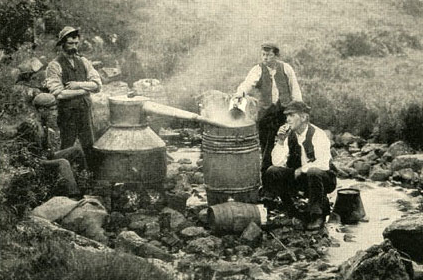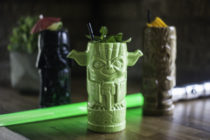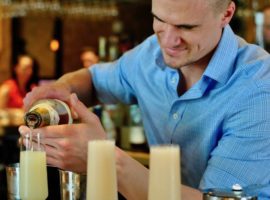Is everybody ready to wear the Irish blue on St. Patrick’s Day? Maybe a nice blue ribbon or blue carnation or a pair of blue suede shoes. Of course we’ll drink some blue beer at the pub and wave the shamrock-splotched blue flag of Ireland’s cricket team and, naturally we will dye the kale and mashed potatoes blue for our traditional dish of colcannon and…
There are 34 million people in America who will claim Irish ancestry on Monday, and I just heard every single one of them howling in outrage. With feisty ancestral blood boiling and fists cocked to take a punch at my nose, every Man Jack and Bonnie Jean of Irish descent just protested: “Hey lady, what are you, crazy!? Sure and begorrah, we’ll be donning the Green come Saint Paddy’s Day, and let no man or his mother try to stop us!”
It might come as a surprise to the loyalists to learn that way back at the very first Feast of St. Patrick (early 5th century AD), the revered saint himself chose blue over green as his team color. Because the wicked faerie folk of Ireland already had dibs on green, and since the pixies outnumbered the Irish in ancient times, arguing with them was as useless as arguing with the British.
Not until the 18th century—when faeries lost their fearsome power and were demoted to the job of harvesting baby teeth from underneath pillows—did Ireland snatch back the color green. Then, painting the proud face of its national identity with an emerald hue, green became the color of rebellion and it stuck.
The Irish spirit is one of extremes. Whether sentimental or fighting mad, whether pulling your leg or pulling your heart strings, whether given to poetry or giving you the what-for, it’s an Irish tradition to pair the emotion with the proper libation.
And being above all else resourceful, if an Irishman is in the mood for either singing to the rafters or swinging a meat hook at a jaw—and believing no matter which way his hubris tilts, it’s a reason to wet the whistle—if a pub cannot be readily accessed, he makes a pub in his own backyard.
Because a great majority of backyards in Ireland once hummed with homemade stills, when the killjoy British came along in 1661 imposing a tax on booze, the moonshiners had to get clever and figure a way to hide the cottage-industry-brewed poitín (or, poteen) from the revenuers. And hide it they did for more than 500 years.
The thrilling illegality of brewing poteen (photo at top) made the drink beloved above all other stimulants in the land of Éire.
What exactly is poteen? Before the potato made it into Ireland, the 95 percent alcohol, double-distilled wallop was made from grain—malted barley, maybe crab apples, maybe a drip or two of treacle. Finally, with the addition of potatoes, even Irish poets could not resist working poitín into paeans about romantic love. Try love with a bottle of poitín and see where it gets you, sang the poets.
Brewed in a small copper pot (from whence the wallop took its name) over a peat moss fire, in the first stages some of the more lethal elements of poteen had to be strained off. This the home brewers did by pouring the deadly liquid into the ground. The ground, by the way, where below the wicked faeries slept, which might explain how the once fey and magical kingdom dissipated into a halfway house for demented tooth fairies.

But counter to the bad-mouthing, other testaments—especially the famous declaration made by 99-year-old Grainne O’Malley who, with her last breath, confessed to the priest: “Father, it was God and poitín that kept me alive”—continued to draw the faithful to the stills.
As clean as the air is round the home-brewing pots in the great outdoors of Ireland, down the road apiece there is always the crowded, smoky alternative. No matter what time of day, no matter what errand is instantly abandoned when sighted, the Irish pub retains its abiding strong-arm hold on the national allegiance.
The Irish pub stands as the proper, legal and most sanctified station in which to wait for the train to glory.
In the village of Dripsey, County Cork, Ireland, the world’s shortest parade will be held on March 17. The march will go exactly 100 yards, which is the distance between the wee town’s only two public houses.
So here we are at the bar. Tankards of Guinness Stout have been poured, the pipes and fiddle band has cranked up a slip jig, and now we are wavering between ordering blaa (a doughy white bun stuffed with corned beef), or boxties (traditional Irish potato pancakes), or a Dublin lawyer (lobster in cream sauce, loaded with Irish whiskey), or crubeens (pickled pigs’ feet) from the murky-looking jar on the bar top.
It’s a cheery place surely, offering a surfeit of food and drink that will be consumed alongside companions that—as the evening progresses toward its inevitable conclusion—you will either hug and promise to introduce to your sister or sock silly.
But before the mood changes for better or worse, look closely at the fellow standing next to you. Do you see a dreamy, faraway longing in his Irish eyes? All of a sudden those Irish eyes are smiling. Could it be that, even though his mouth is at the pub, his heart is in the hills with the stills?
Come guess me this riddle, what beats pipes and fiddle,
What’s hotter than mustard, and milder than cream,
What best wets your whistle, what’s clearer than crystal,
What’s sweeter than honey and stronger than steam?
Better stick to the cratur’ (moonshine), the best thing in nature.
For sinking your sorrows and raising your joys,
Oh lord, tis the right thing for courting and fighting,
There’s nowt so exciting as poteen, me boys!
(From The Humours of Whiskey, traditional Irish folk song)







Follow Us